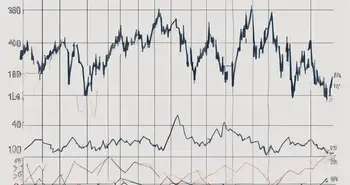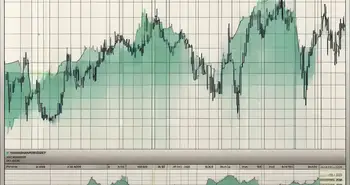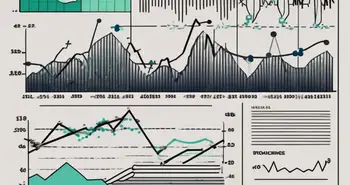The McClellan Oscillator: A Perfect Guide

As an expert in market analysis, I am excited to share with you a comprehensive guide on understanding the McClellan Oscillator. This powerful tool has gained popularity among traders and investors for its ability to provide valuable insights into market trends. In this article, we will delve into the basics of the McClellan Oscillator, its mechanics, practical application, limitations, and more. So, let's get started!
The Basics of the McClellan Oscillator
What is the McClellan Oscillator?
The McClellan Oscillator is a technical analysis indicator that measures market breadth, indicating the overall health of the stock market. Developed by Sherman and Marian McClellan, this oscillator helps traders and investors identify the strength and direction of market trends.
By analyzing the daily difference between advancing and declining stocks, the McClellan Oscillator calculates the net advance-decline (A-D) line. This A-D line is then smoothed using exponential moving averages to generate the oscillator values.
The McClellan Oscillator is a versatile tool that can be applied to various timeframes, from intraday to long-term analysis. It can be used for different markets, including stocks, indices, and even commodities. Traders and investors often use it in conjunction with other technical indicators to gain a comprehensive understanding of market conditions.
When interpreting the McClellan Oscillator, traders look for key levels and patterns. A positive reading suggests that advancing stocks are dominating, indicating a bullish market sentiment. Conversely, a negative reading indicates that declining stocks have the upper hand, signaling a bearish sentiment.
Traders also pay attention to extreme readings in the oscillator. An extremely high positive reading may indicate an overbought condition, suggesting that the market is due for a correction. On the other hand, an extremely low negative reading may suggest an oversold condition, potentially signaling a market bottom.
The Importance of the McClellan Oscillator in Market Analysis
The McClellan Oscillator plays a crucial role in market analysis by providing insights into market breadth. It helps traders and investors identify overbought or oversold conditions, potential market reversals, and the overall health of the market.
By monitoring the oscillator values, traders can spot divergences between the oscillator and market indices, which can signal a potential change in market direction. This can be a valuable tool for traders looking to make informed decisions and optimize their trading strategies.
Moreover, the McClellan Oscillator can be used to confirm or validate other technical indicators. For example, if a trend reversal is indicated by a moving average crossover, the oscillator can provide additional confirmation by showing a divergence from the prevailing trend.
Another important aspect of the McClellan Oscillator is its ability to identify market breadth thrusts. These thrusts occur when the oscillator moves from extreme negative to extreme positive territory within a short period. Market breadth thrusts are often associated with significant market rallies, indicating a strong and sustainable uptrend.
Additionally, the McClellan Oscillator can be used to analyze market internals. By comparing the oscillator values with the price action of individual stocks, traders can gain insights into the underlying strength or weakness of specific sectors or industries.
In conclusion, the McClellan Oscillator is a powerful tool that provides valuable insights into market breadth and helps traders and investors make informed decisions. Its versatility and ability to identify overbought or oversold conditions, potential reversals, and market breadth thrusts make it a valuable addition to any trader's toolbox.
The Mechanics of the McClellan Oscillator
The McClellan Oscillator is a popular technical analysis tool used by traders and investors to gauge the overall health and direction of the stock market. It provides valuable insights into market sentiment and helps identify potential reversal points. Understanding the mechanics of this oscillator is essential for anyone looking to make informed trading decisions.
The Calculation Process
The calculation process of the McClellan Oscillator involves several steps that aim to filter out short-term noise and provide a more accurate representation of the underlying market trends.
First, the 39-day exponential moving average (EMA) of advancing issues is calculated. This moving average gives more weight to recent data points, reflecting the current market conditions. It represents the average price movement of stocks that are advancing or experiencing an upward trend.
Next, the 19-day EMA of declining issues is calculated. This moving average focuses on stocks that are declining or experiencing a downward trend. By subtracting the 19-day EMA of declining issues from the 39-day EMA of advancing issues, the McClellan Oscillator captures the difference between the two, indicating the overall market breadth.
Finally, the resulting value is smoothed with a 5-day EMA. This additional smoothing helps eliminate any short-term fluctuations and provides a more reliable signal for traders and investors.
Interpreting the Oscillator Values
The McClellan Oscillator values range from negative to positive, providing valuable insights into market sentiment and potential trading opportunities.
Positive values indicate that there are more advancing stocks than declining stocks in the market. This suggests a bullish market sentiment, where buyers are in control and prices are generally rising. Traders may interpret this as a signal to enter long positions or hold onto existing ones.
Conversely, negative values indicate that there are more declining stocks than advancing stocks. This suggests a bearish market sentiment, where sellers are in control and prices are generally falling. Traders may interpret this as a signal to enter short positions or consider selling existing ones.
Extreme values, either highly positive or highly negative, indicate overbought or oversold conditions, respectively. An overbought condition suggests that the market may be due for a correction or reversal, as prices have risen too far too quickly. An oversold condition suggests that the market may be due for a bounce or reversal, as prices have fallen too far too quickly. These extreme values can serve as potential reversal points, offering traders opportunities to enter or exit positions.
It is important to note that the McClellan Oscillator is just one tool among many in a trader's toolbox. It should be used in conjunction with other technical indicators and analysis methods to make well-informed trading decisions.
In conclusion, the McClellan Oscillator is a powerful tool that helps traders and investors understand market breadth and sentiment. By calculating the difference between advancing and declining issues and smoothing the resulting value, it provides valuable insights into potential market reversals and trading opportunities. Incorporating the McClellan Oscillator into your trading strategy can enhance your ability to navigate the stock market with confidence and precision.
The McClellan Oscillator and Market Trends
Identifying Bullish and Bearish Trends
The McClellan Oscillator is a powerful tool for identifying bullish and bearish trends in the stock market. When the oscillator remains consistently positive, it suggests a strong bullish trend. Conversely, a consistently negative oscillator indicates a strong bearish trend.
Traders often use these trends as a guide when making investment decisions. Buying or trading with the trend can increase the chances of success, while going against the trend can be riskier.
Oscillator Divergences and Market Reversals
Divergences between the McClellan Oscillator and market indices can provide valuable insights into potential market reversals. When the market index reaches new highs or lows, but the oscillator fails to confirm these moves, it is known as a divergence.
These divergences can indicate a loss of momentum or a change in market sentiment, suggesting a possible market reversal. Traders can use these divergences to anticipate trend changes and adjust their trading strategies accordingly.
Practical Application of the McClellan Oscillator
Incorporating the Oscillator into a Trading Strategy
Integrating the McClellan Oscillator into a trading strategy can enhance decision-making by providing additional confirmation signals. Traders can combine the oscillator readings with other technical indicators, such as moving averages or trend lines, to form a more comprehensive analysis of the market.
For example, a trader may use the oscillator to confirm a bullish trend indicated by price action and moving averages. When all these elements align, it increases the confidence in the trading decision.
Common Mistakes to Avoid When Using the Oscillator
While the McClellan Oscillator can be a valuable tool, it is essential to avoid common mistakes that can lead to misinterpretation. One common mistake is relying solely on the oscillator without considering other factors, such as fundamental analysis or market news. To make well-informed decisions, it is crucial to consider multiple sources of information.
Additionally, traders should avoid using the oscillator as a stand-alone indicator for market timing. Like any technical indicator, it is best used in conjunction with other tools to confirm and validate trading decisions.
Limitations of the McClellan Oscillator
Potential Drawbacks and Misinterpretations
While the McClellan Oscillator is a powerful market breadth indicator, it is not without limitations. One potential drawback is its sensitivity to a small number of large-cap stocks. If a few heavily weighted stocks dominate the market, it can skew the oscillator readings and lead to misinterpretations.
Traders should also be aware that the oscillator is most effective in trending markets and may generate false signals in choppy or sideways markets. Understanding these limitations can help traders navigate the market more effectively.
The Oscillator in Different Market Conditions
It is important to consider the prevailing market conditions when interpreting the McClellan Oscillator. In robust and healthy markets, the oscillator can provide reliable signals. However, in volatile or uncertain markets, the oscillator may produce mixed or contradictory readings.
During periods of extreme market volatility, it is advisable to exercise caution and consider additional factors before making trading decisions solely based on the oscillator.
Having a deep understanding of the McClellan Oscillator can empower traders and investors to make more informed decisions in the stock market. By incorporating this powerful tool into their analysis, traders can identify market trends, anticipate reversals, and refine their trading strategies. Remember, like any indicator, the McClellan Oscillator is most effective when used in conjunction with other analysis techniques. So, embrace this comprehensive guide and take your trading to the next level!
FAQ
Q: What is the McClellan Oscillator?
The McClellan Oscillator is a technical analysis indicator that measures market breadth, indicating the overall health of the stock market.
Q: How is the McClellan Oscillator calculated?
The McClellan Oscillator is calculated by subtracting the 19-day exponential moving average of declining issues from the 39-day exponential moving average of advancing issues, and then smoothing the resulting value with a 5-day exponential moving average.
Q: How can the McClellan Oscillator be used in trading?
Traders can use the McClellan Oscillator to identify bullish and bearish trends, spot potential market reversals through divergences, and incorporate the oscillator into their trading strategies to enhance decision-making.
Q: What are the limitations of the McClellan Oscillator?
The McClellan Oscillator may be influenced by a small number of large-cap stocks and can generate false signals in volatile or sideways markets. Traders should consider these limitations and analyze the oscillator in conjunction with other factors.
Ready to take your market analysis to the next level with the McClellan Oscillator? Discover the future of trading with Morpher, the innovative platform that combines the power of blockchain technology with zero fees, infinite liquidity, and the ability to trade across a multitude of asset classes. Whether you're looking to invest in stocks, cryptocurrencies, or even niche markets like NFTs, Morpher offers fractional investing, short selling without interest fees, and up to 10x leverage to enhance your trading strategy. Sign up now to experience a unique trading environment and get your free sign up bonus. Embrace the change with Morpher and transform the way you trade.

Disclaimer: All investments involve risk, and the past performance of a security, industry, sector, market, financial product, trading strategy, or individual’s trading does not guarantee future results or returns. Investors are fully responsible for any investment decisions they make. Such decisions should be based solely on an evaluation of their financial circumstances, investment objectives, risk tolerance, and liquidity needs. This post does not constitute investment advice.

Painless trading for everyone
Hundreds of markets all in one place - Apple, Bitcoin, Gold, Watches, NFTs, Sneakers and so much more.

Painless trading for everyone
Hundreds of markets all in one place - Apple, Bitcoin, Gold, Watches, NFTs, Sneakers and so much more.









